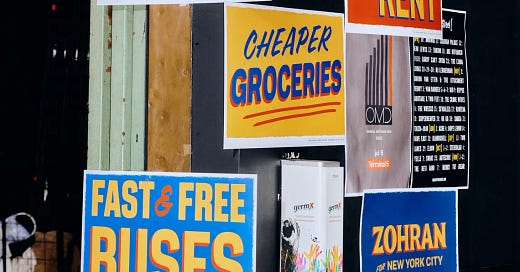Zohran Mamdani Didn’t Run a Campaign; He Built a Movement
What marketers can learn from his unapologetic message, bold positioning, and refusal to play it safe
People tell me not to talk about politics. I get it. But this post isn’t really about politics. It’s about communication. It’s about movement-making. It’s about what breaks through in a world flooded with noise.
As I’ve gotten older, I’ve become more interested in politics, not because I want to argue party lines, but because it reveals what people believe, fear, and hope for. If you're serious about marketing, you should pay attention to politics. It’s where strategy meets reality. It’s where stories either land or collapse.
And that’s why I want to talk about Zohran Mamdani. However, I first need to explain why I had to leave New York.
Why I Left a City I Still Love
I didn’t want to leave because I love New York, and I still do.
There’s an energy here that doesn’t exist anywhere else. The people are brilliant, ambitious, and resilient. The culture, the creativity, the collisions of ideas, it’s electric. Just walking around Manhattan, you feel possibility.
But two things can be true at once.
New York is inspiring.
And New York is exhausting.
It’s magnetic and it’s brutal.
I left because the basics stopped working. Rent was crushing. Groceries were insane. A gallon of milk regularly costs 30% more than in Yonkers. Restaurants that didn’t even deliver good food cost me a hundred bucks. I wasn’t living, I was grinding.
And then there’s the constant friction:
Parking is a joke. Either pay $600/month or circle endlessly and risk a ticket.
Red light cameras. Bus lane traps. Petty fines.
Overflowing garbage cans.
Subways that feel dangerous.
Mental illness and homelessness are everywhere.
A city that feels, frankly, like it’s given up on itself.
At some point, I had to ask myself:
Is being closer to my kids worth the debt, anxiety, and constant stress?
The answer was no. So I left.
Why Mamdani’s Win Landed So Hard
When Zohran Mamdani beat Cuomo in the Democratic primary, it felt like someone finally said the quiet part out loud:
New York isn’t working for the people who make it run.
His platform wasn’t subtle:
Free MTA buses
A $30/hour minimum wage by 2030
City-owned grocery stores
Universal childcare for kids aged 6 weeks to 5 years
A rent freeze for 2 million stabilized apartments
Taxes on the ultra-wealthy and corporations to pay for it
To some, it sounded extreme. To me, it sounded honest.
It wasn’t calculated to “appeal to moderates.” It was a clear stand for working people.
And if you’re someone who doesn’t feel the struggle, if your rent is manageable, your fridge is full, and your life is stable, this platform probably didn’t speak to you. But it wasn’t supposed to.
There’s no incentive to care when the system already works for you.
But millions of people are drowning. And Mamdani spoke directly to that.
Even if only part of his agenda gets traction, that’s more than what we’ve seen from most politicians who offer tweaks instead of transformation.
He Didn’t Just Say Something Different; He Looked Different
Mamdani’s campaign didn’t just sound bold—it looked bold.
Let’s start with the obvious: he doesn’t look like your typical politician.
Not in how he dresses. Not in how he carries himself. Not in how he shows up in a room.
He’s not trying to project authority in the traditional, buttoned-up, “electable” way. And that’s part of the power. Because he’s not performing politics, he’s showing up as himself. It makes him more believable, more relatable, and way more magnetic than the polished candidates who feel like they were created in a donor lab.
And the branding around him? Same story.
Most political campaigns resemble those designed by a bank: red, white, and entirely forgettable. Mamdani’s branding looked like the city he was fighting for.
Credit where credit is due: the visual identity—designed by Aneesh Bhoopathy of the Forge co-op and profiled in Curbed—was stunning, human, and entirely unlike anything else in politics.
A bold, saturated mustard yellow inspired by NYC taxicabs, MetroCards, and bodega awnings
Royal blue and vermilion drop shadows for high contrast and neighborhood familiarity
A hand-drawn logotype that mimicked classic storefront signage across Queens
Fonts that felt like hand-painted grocery signs, not political consultant templates
As Curbed put it, it was “bodega-influenced visual language,” and it worked.
It didn’t look like a Fortune 500 logo trying to pass as populist.
It looked like something from New York, not just about New York. It was specific. Street-level. Alive.
There was charisma in the posters, authenticity in the signage.
Even the now-iconic “HOT GIRLS FOR ZOHRAN” T-shirt said what most campaigns won’t:
This isn’t for everyone—and that’s the point.
Compare that to Cuomo’s campaign.
Actually—don’t.
Nobody remembers what it looked like.The Marketing Lesson
Mamdani told his truth.
Whether it’s your truth is up to you. But the fact that he told it clearly, repeatedly, and with conviction, is why people showed up for him.
Because when politicians (or brands) rely on generic talking points, when they try to appeal to everyone, when they avoid conflict in the name of safety—they lose relevance. They lose connection. They attract attention but never build advocacy.
Mamdani didn’t do that.
He built a real message. A real identity. A real following.
That’s what it takes to build a brand that means something.
So if you’re in marketing, stop polishing. Stop hedging. Stop trying to be everything to everyone.
Take a stand. Tell your truth. Build something people care about.
Whether Mamdani wins the general or not, that’s what he’s already accomplished.
And that’s what the rest of us should be learning from.





This is a great article! I can understand your reluctance to post this on LinkedIn. But it really explains, frim a communications perspective, why Zohran Mamdani ran a successful campaign.